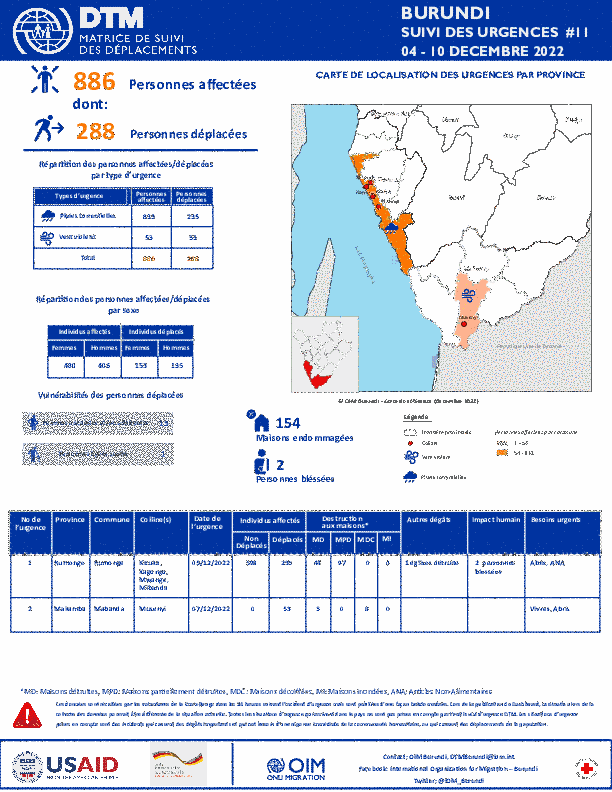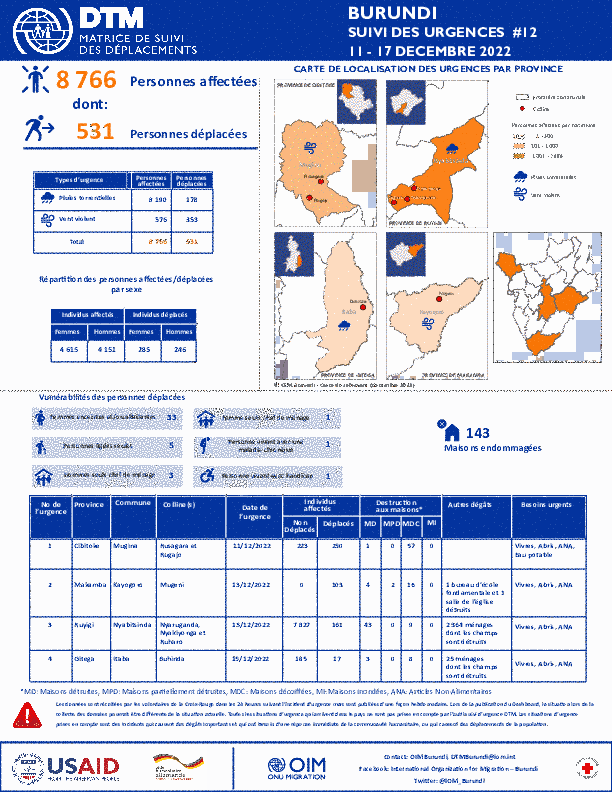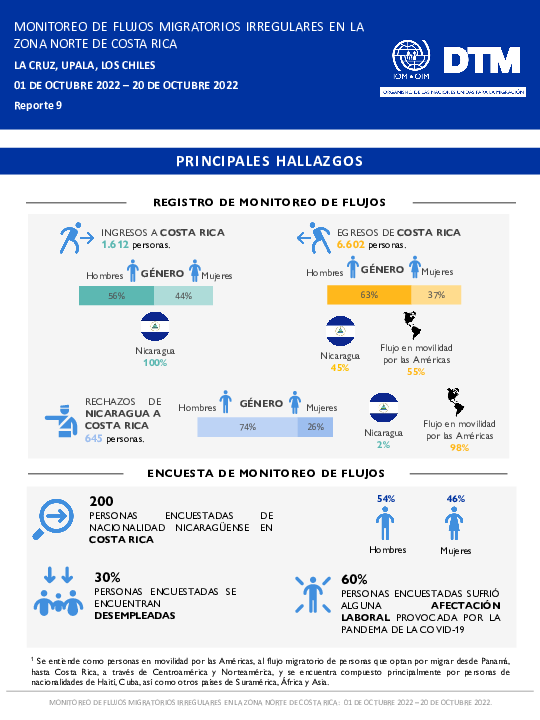-
Countries
-
Data and Analysis
-
Special Focus
-
Crisis Responses

Contact
DTM Burundi, DTMBurundi@iom.int
Language
French
Location
Burundi
Period Covered
Dec 04 2022
Dec 10 2022
Activity
- Mobility Tracking
- Event Tracking
Entre le 4 au 10 décembre 2022, la DTM a identifié 886 personnes affectées dont 288 personnes déplacées par les pluies torrentielles et les vents violents.

Contact
DTM Zimbabwe, DTMzimbabwe@iom.int, DTMsupport@iom.int
Language
English
Location
Zimbabwe
Period Covered
Nov 01 2022
Nov 30 2022
Activity
- Flow Monitoring
During the month of November 2022, a total of 48,755 movements were recorded and 3,245 migrants were interviewed across 33 Flow Monitoring Points (FMPs) in Zimbabwe. The total movements recorded increased by 8% compared to the previous month. 61% of movements observed were inflows, whilst 39% were outflows. The top three sending districts were Beitbridge (43%), Harare (13%), and Masvingo (6%).
The South Africa-Zimbabwe corridor recorded the highest movement of 38,422 (79%) followed by the Zambia-Zimbabwe corridor which recorded 6,144 (13%) movements. Thirty-four per cent of movements along the South Africa-Zimbabwe corridor were short-term local movements. These are characterized by movements of less than 6 months of people travelling to conduct commercial activities, travelling to access services and daily regular commuting. Twenty-six per cent of movements along the South Africa- Zimbabwe corridor were family reunifications, and 24% were long-term economic movements. The Zambia-Zimbabwe corridor consisted of 72% short-term movements, and 16% long-term economic movements. Forty-four per cent of movements along the Botswana-Zimbabwe corridor were long-term economic movements. Sixty per cent of long-term economic movements were outflows while fifty-six of short-term local movements were inflows. The reporting period has generally been characterized by an increase in movements as a result of the approaching holiday seasons. Movements are predominantly for family reunification and travellers conducting commercial activities in anticipation for the December holiday season.

Contact
DTM Zimbabwe, DTMzimbabwe@iom.int, DTMsupport@iom.int
Language
English
Location
Zimbabwe
Period Covered
Oct 01 2022
Oct 31 2022
Activity
- Flow Monitoring
During the month of October 2022, a total of 44,995 movements were recorded and 3,089 migrants were interviewed across 43 Flow Monitoring Points (FMPs) in Zimbabwe. The total movements recorded decreased by 5% compared to the previous month. 60% of movements observed were inflows, whilst 40% were outflows. The top three sending districts were Beitbridge (41%), Harare (12%), and Chiredzi (8%) and the top receiving districts were Harare (22%), Beitbridge (20%) and Bulawayo (8%).
South Africa-Zimbabwe corridor recorded the highest movement of 37,710 (80%) followed by Zambia-Zimbabwe corridor which recorded 5,139(11%) movements. Out of the 19, 959 outflows observed, 77% of were recorded along irregular crossing points compared to 38% of inflows. Most migrants chose to use formal crossing points when entering the country. The cited reasons for using informal crossing points were lack of travelling documents, proximity to intended destination and proximity to service centres such as clinics and workplaces. Migrants prefer using the formal entry points when returning to the country since there are no restrictions when returning to the country of origin and also due to the high security risks encountered when using informal crossing points. An increase in the number of outgoing migrants can be attributed to the return of migrants to their livelihood activities following the August holidays. Beitbridge Border Post, Dite and Chituripasi were the preferred exit points accounting for 34% of outflows whilst Beitbridge border post was the preferred entry point recording 46% of inflows followed by Maroyi (5%) and Chirundu border post (5%).
Contact
DTM Burundi, DTMBurundi@iom.int
Location
Burundi
Activity
- Mobility Tracking
- Event Tracking
Period Covered
Dec 11 2022 -Dec 17 2022
Activated on an ad hoc basis, the DTM Emergency Tracking provides early field reports at the beginning of a complex crisis, allowing IOM to gather, consolidate and disseminate baseline information on displacement and return figures at the onset of a newly emerging crisis. The DTM Emergency Tracking relies heavily on information provided by RARTs or partners within the humanitarian community about an unfolding situation. The Emergency Tracking gathers data through IOM Burundi’s extended network of key informants, who provide basic information on the new displacement, be it of IDPs or returnees, or both, including numbers, location and shelter types. While IOM DTM strives to provide best estimates, the Emergency Tracking aims to be a quick monitoring tool with real-time data turnover ranging from 24 to 72 hours following its activation.
Population Groups
Survey Methodology
Unit of Analysis Or Observation
Type of Survey or Assessment
Keywords
Geographical Scope
Administrative boundaries with available data
The current dataset covers the following administrative boundaries
Contact
DTM Burundi, DTMBurundi@iom.int
Location
Burundi
Activity
- Mobility Tracking
- Event Tracking
Period Covered
Dec 04 2022 -Dec 10 2022
Activated on an ad hoc basis, the DTM Emergency Tracking provides early field reports at the beginning of a complex crisis, allowing IOM to gather, consolidate and disseminate baseline information on displacement and return figures at the onset of a newly emerging crisis. The DTM Emergency Tracking relies heavily on information provided by RARTs or partners within the humanitarian community about an unfolding situation. The Emergency Tracking gathers data through IOM Burundi’s extended network of key informants, who provide basic information on the new displacement, be it of IDPs or returnees, or both, including numbers, location and shelter types. While IOM DTM strives to provide best estimates, the Emergency Tracking aims to be a quick monitoring tool with real-time data turnover ranging from 24 to 72 hours following its activation.
Population Groups
Survey Methodology
Unit of Analysis Or Observation
Type of Survey or Assessment
Keywords
Geographical Scope
Administrative boundaries with available data
The current dataset covers the following administrative boundaries

Contact
DTM Europe, DTMMediterranean@iom.int
Language
English
Location
Republic of Moldova
Period Covered
Oct 07 2022
Nov 09 2022
Activity
- Survey
- Flow Monitoring
On 24 February 2022, the Russian Federation invaded Ukraine and triggered an unprecedented humanitarian crisis and forcibly displaced people within Ukraine and to neighboring countries. The Republic of Moldova is one of the main refugee-hosting countries and a transit country for those moving onward. Between 24 February 2022 and 10 November 2022, an estimated 806,513 Ukrainian citizens entered the Republic of Moldova (based on General Inspectorate of Border Police data (GIBP)). During this period, while a large number of people were displaced to other European countries, approximately 95,718 Ukrainian citizens sought refuge in the Republic of Moldova (source: GIBP data). In response to the refugee influx in the Republic of Moldova, the Moldovan government, with the support of the United Nations (UN) agencies, international and national non-governmental partners, have been providing support, including but not limited to, access to food and shelter, access to health services, employment opportunities and education for children. To inform an evidence-based response, the International Organization for Migration (IOM) conducted a displacement survey to identify basic needs and intentions of refugees from Ukraine and third-country nationals (TCNs), entering the Republic of Moldova from Ukraine since March 2022. The first round of the Displacement Survey on Intentions was conducted between 9 March to 12 May 2022 (link to report), and the second round began on 6 September 2022 and data collection is ongoing. This is the second report presenting findings from the second round of data collection. It summarizes the key findings of the displacement survey conducted by IOM’s Displacement Tracking Matrix (DTM), between 07 October and 09 November 2022, in four entry and exit Border Crossing Points (BCPs) between the Republic of Moldova and both Ukraine and Romania. The findings presented are based on 1,191 interviews with refugees from Ukraine and TCNs, entering the country, of which 396 were conducted in Otaci BCP (North-East), 394 in Palanca BCP (South-East), 241 in Leuseni BCP (West) and 160 in Giurgiulesti BCP (South).

Contact
DTM Burundi, DTMBurundi@iom.int
Language
French
Location
Burundi
Period Covered
Dec 11 2022
Dec 17 2022
Activity
- Mobility Tracking
- Event Tracking
Entre le 11 au 17 décembre 2022, la DTM a identifié 8 766 personnes affectées dont 531 personnes déplacées par les pluies torrentielles et les vents violents.

Contact
Angélica Madrigal amadrigal@iom.int
Language
Spanish
Location
Costa Rica
Period Covered
Oct 01 2022
Oct 31 2022
Activity
- Survey
- Registration
- Flow Monitoring
Durante el periodo de tiempo que abarca el presente informe, se logró observar un total de 8.214 personas que cruzaron irregularmente (ingresos y egresos) en los tres puntos de monitoreo de la frontera entre Costa Rica y Nicaragua, y 645 rechazos de Nicaragua a Costa Rica. Además, de un total de 240 personas a las que se les solicitó participar en la encuesta, 200 accedieron, lo que significa que hubo una tasa de respuesta del 83 por ciento. Estas encuestas se aplican a personas migrantes nicaragüenses en centros de agrupación y tránsito cotidiano, como terminales de autobuses o paradas de taxis informales. La recolección de información se ha realizado todos los días de la semana, entre 8:00 a.m. y 3:00 p.m. (desde 01 de octubre al 20 de octubre de 2022).
Estos datos son una medida dinámica para el recuento de personas que cruzan una frontera una o varias veces en un periodo establecido, no representan estimaciones generalizables del flujo migratorio irregular de Costa Rica por la frontera norte, por lo que deben interpretarse como un marco de referencia sobre las características de las personas migrantes irregulares de Costa Rica en un determinado periodo de tiempo y en determinados sitios de monitoreo.
Complementariamente a la elaboración de este informe se realizaron dos grupos focales en el cantón de Upala con la participación de 17 personas migrantes nicaragüenses (16 mujeres y un hombre), en los que se profundizó cualitativamente las categorías de necesidades, integración y vulnerabilidades a partir de la adaptación de las preguntas del cuestionario de DTM hacia el componente cualitativo. Las personas participantes provienen de las comunidades: Canalete, Cartago de Upala, centro de Upala, Fósforo, Moreno Cañas y México de Upala.

Contact
Angélica Madrigal amadrigal@iom.int
Language
Spanish
Location
Costa Rica
Period Covered
Sep 01 2022
Sep 30 2022
Activity
- Survey
- Registration
- Flow Monitoring
Durante el periodo de tiempo que abarca el presente informe, se logró observar un total de 9 373 personas que cruzaron irregularmente (ingresos y egresos) en los tres puntos de monitoreo de la frontera entre Costa Rica y Nicaragua, y 594 rechazos de Nicaragua a Costa Rica Además, de un total de 409 personas a las que se les solicitó participar en la encuesta, 347 accedieron, lo que significa que hubo una tasa de respuesta del 85 por ciento Estas encuestas se aplican a personas migrantes nicaragüenses en centros de agrupación y tránsito cotidiano, como terminales de autobuses o paradas de taxis informales La recolección de información se ha realizado todos los días de la semana, entre 8 00 a m y 3 00 p m (desde 01 de septiembre al 30 de septiembre de 2022).
Estos datos son una medida dinámica para el recuento de personas que cruzan una frontera una o varias veces en un periodo establecido, no representan estimaciones generalizables del flujo migratorio irregular de Costa Rica por la frontera norte, por lo que deben interpretarse como un marco de referencia sobre las características de las personas migrantes irregulares de Costa Rica en un determinado periodo de tiempo y en determinados sitios de monitoreo.

Contact
DTMUkraine@iom.int
Language
English
Location
Ukraine
Period Covered
Nov 25 2022
Dec 05 2022
Activity
- Survey
Starting on 24 February 2022, a large-scale armed conflict in Ukraine triggered an unprecedented humanitarian crisis across the country, characterised, among other elements, by the displacement of a significant proportion of the Ukrainian population.
As early as April 2022, the International Organization for Migration (IOM) began observing significant return movements. Conditions of return vary widely, as returnees arrive back to areas not directly affected by the war, but which have experienced a significant influx of internally displaced persons (IDPs), as well as to conflict-affected and recently de-occupied areas which have sustained severe damage. Due to the volatility of the current situation, it is impossible to determine what proportion of the returns observed at present are permanent or temporary. Existing data shows, however, that the returnee population in Ukraine is characterized by a unique set of needs and vulnerabilities which set it apart from those who had never been displaced and from the population of IDPs.
To support partners in providing targeted, evidence-based assistance to those returning to their areas of habitual residence following a period of forced displacement, IOM presents the Ukraine Returns Report. This publication will strive to analyze IOM’s latest data on the situation and needs of the returnee population and on the conditions of return, collected through the Displacement Tracking Matrix (DTM) assessments conducted in the country.
This December 2022 edition of the Ukraine Returns Report presents a detailed analysis of data collected through the eleventh round of IOM’s General Population Survey (GPS), conducted 25 November and 5 December 2022 among the adult population in Ukraine. The geographical scope of the assessment covers the entire territory of Ukraine, all five macro-regions (West, East, North, Centre, South, and the city of Kyiv), with the exception of the Crimean peninsula and the non-government-controlled-areas of Ukraine (NGCA). The general population survey was conducted using a random‐digit‐dial (RDD) approach, and 2,002 unique and anonymous respondents aged 18 and over were interviewed using the computer-assisted telephone interview (CATI) method.
